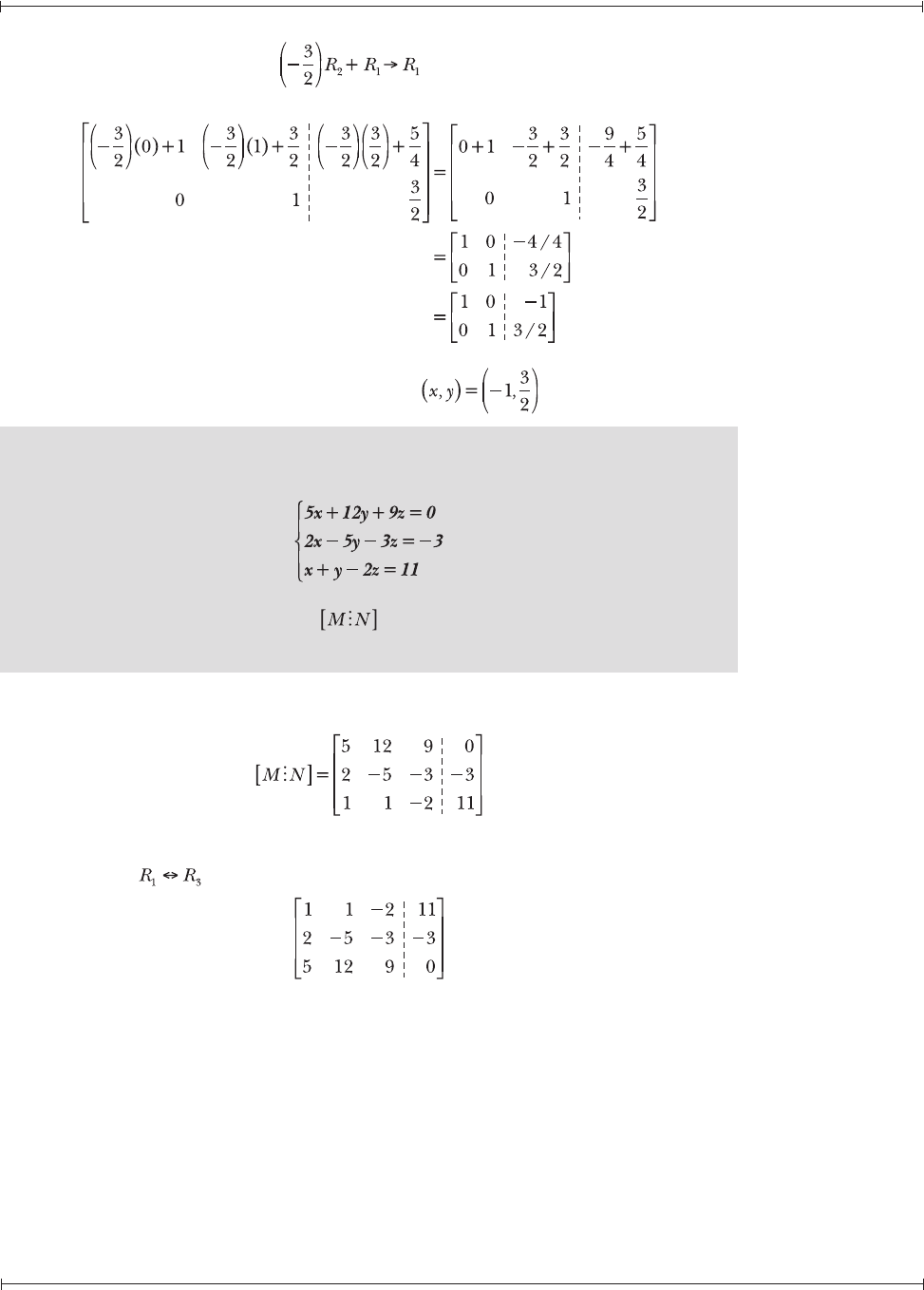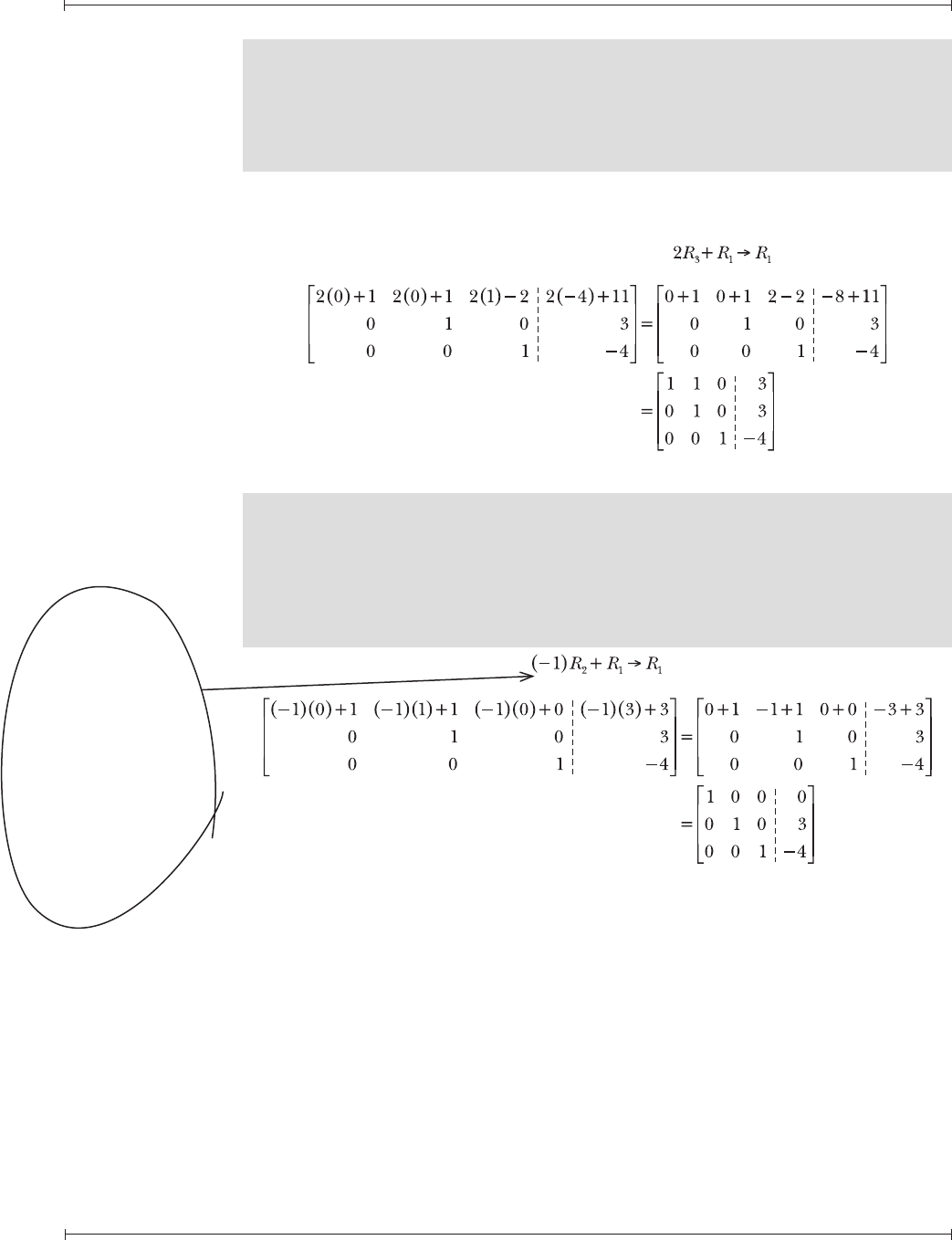
Chapter Ten — Applications of Matrix Algebra
The Humongous Book of Algebra Problems
221
Apply the row operation to make a
12
= 0.
The solution to the system of equations is .
Note: Problems 10.26–10.31 present the steps necessary to solve the system of equations
defined below using an augmented matrix.
10.26 Construct augmented matrix to represent the system and perform a
row operation to make m
11
= 1.
Matrix M contains the coefficients of the system and matrix N contains the
constants right of the equal sign in each equation.
The most efficient way to make m
11
= 1 is to switch the first and third rows of the
matrix: .

Chapter Ten — Applications of Matrix Algebra
The Humongous Book of Algebra Problems
222
Note: Problems 10.26–10.31 present the steps necessary to solve the system of equations
defined in Problem 10.26 using an augmented matrix.
10.27 Perform row operations on the matrix generated by Problem 10.26 to make
m
21
= 0 and m
22
= 1.
Perform the row operation to make m
21
= 0. When m
11
= 1 (the
goal of Problem 10.26), you should multiply the first row by the opposite of
m
21
= 2, add it to the second row, and replace the elements in the second row
with the results.
Multiply the second row by , the reciprocal of m
22
= –7, to make
m
22
= 1: .
Note: Problems 10.26–10.31 present the steps necessary to solve the system of equations
defined in Problem 10.26 using an augmented matrix.
10.28 Express the matrix generated by Problem 10.27 in row echelon form.
Perform the row operation to make m
31
= 0. Use the first row
to transform m
31
because it has 1 in the same column as m
31
.
Make m
32
= 0 using the row operation . Note that the second
row is used (instead of the first row, which was used to change m
31
) because it
contains 1 in the same column as m
32
and has zeros left of that element.
When you get
the upper-left
element to equal
1 in a 3 × 3 matrix,
focus on the second
row. The left element
needs to equal 0 and
the middle element
needs to be 1.
RULE
OF THUMB:
Whenever you’re
trying to make
something equal 0,
you multiply a row
by the opposite of
the number that’s
going to disappear
and then add rows
together. When
you’re trying to make
something equal 1,
you divide a row by
the number that
needs to go.
You’re trying
to make all the
elements in the
diagonal (m
11
, m
22
, and
m
33
) into ones. In this step,
you’ve got to make
m
33
= 1, but to do that,
both numbers LEFT
of m
33
have to
be 0.

Chapter Ten — Applications of Matrix Algebra
The Humongous Book of Algebra Problems
223
Apply the row operation to make m
33
= 1 and thus express the
augmented matrix in row echelon form.
Note: Problems 10.26–10.31 present the steps necessary to solve the system of equations
defined in Problem 10.26 using an augmented matrix.
10.29 Perform a row operation on the matrix generated by Problem 10.28 to make
m
23
= 0.
Multiply the third row by the opposite of m
23
, add rows two and three, and
replace row two with the results: . Note that the third row is
used to change m
23
because it contains 1 in the same column as m
23
and all the
elements left of 1 are zeros.
Now it’s time
to start making the
elements ABOVE the
diagonal into 0s.

Chapter Ten — Applications of Matrix Algebra
The Humongous Book of Algebra Problems
224
Note: Problems 10.26–10.31 present the steps necessary to solve the system of equations
defined in Problem 10.26 using an augmented matrix.
10.30 Perform a row operation on the matrix generated by Problem 10.29 to make
m
13
= 0.
Use the method described in Problem 10.29 to change an element in the third
column into 0; multiply the third row by the opposite of the number to be
eliminated (m
13
= –2, so multiply by 2), add the first and third rows, and replace
the elements of the first row with the results: .
Note: Problems 10.26–10.31 present the steps necessary to solve the system of equations
defined in Problem 10.26 using an augmented matrix.
10.31 Perform a row operation on the matrix generated by Problem 10.30 to make
m
12
= 0 and therefore express the augmented matrix in reduced-row echelon
form. Identify the solution to the system of equations.
Perform the row operation to make m
12
= 0.
The column of constants contains the solution to the system: (x,y,z) = (0,3,–4).
To get rid
of m
12
, multiply
the second row
by its opposite. Why
use the second row?
It has 1 in the same
column as m
12
and
zeros everywhere else
(except across the
dotted line, and
that doesn’t
matter).

Chapter Ten — Applications of Matrix Algebra
The Humongous Book of Algebra Problems
225
Note: Problems 10.32–10.33 refer to the system of equations below.
10.32 Construct an augmented matrix that represents the system and express
it in row echelon form.
Matrix A contains the coefficients of the system and B contains the constants
right of the equal sign.
Perform the row operation to make a
11
= 1.
Make a
21
= 0 by applying the row operation .
Apply the row operation to place a 1 in the second element of the
diagonal, a
22
.
There’s no x-
term in the third
equation (3y + 8z = 5)
so set a
31
= 0, because
it represents the x-
coefcient of the
third equation.
..................Content has been hidden....................
You can't read the all page of ebook, please click here login for view all page.
